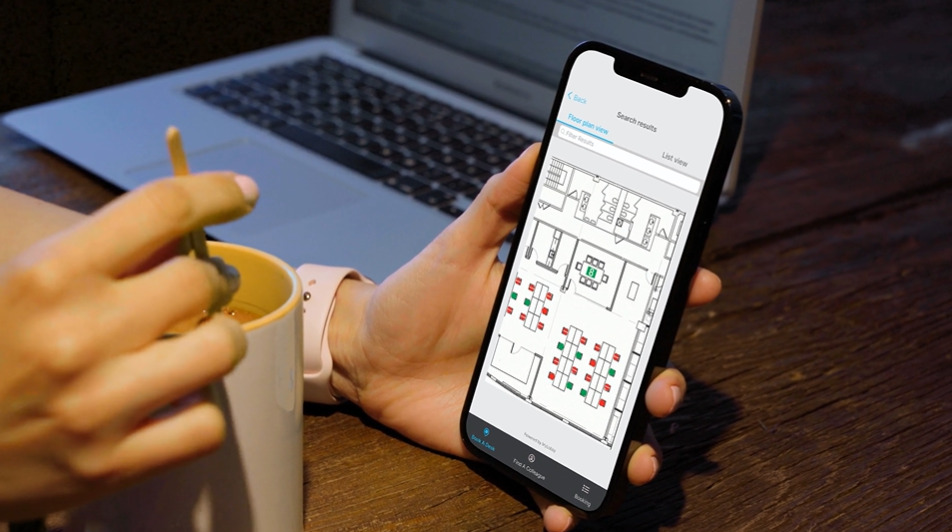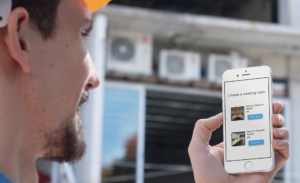In today’s evolving work landscape, the concept of hot desking has gained significant traction. It offers flexibility, collaboration, and cost-saving opportunities for businesses of all sizes. But is hot desking truly the future of work? Let’s examine the pros and cons.
One of the major advantages of hot desking is the increased opportunities for collaboration and networking. By sharing a workspace with different individuals and teams, employees can easily connect with others, exchange ideas, and foster innovation.
Additionally, hot-desking allows companies to optimize their office space, reducing costs and promoting efficiency. With employees not tied to specific workstations, companies can create a more dynamic and agile work environment.
However, there are also drawbacks to consider. Hot desking can lead to a lack of personalization and privacy, as employees do not have their own dedicated space. It may also increase the risk of distractions and interruptions, affecting productivity levels.
Ultimately, whether hot desk booking is the future of work depends on the specific needs and culture of each organization. By weighing the advantages and disadvantages, companies can make informed decisions about implementing this approach in their workplace.
What is hot desking

Hot desking is a flexible working arrangement where employees do not have assigned desks or workstations. Instead, they have the freedom to choose any available workspace within a shared office environment. This setup allows for a more dynamic and collaborative work environment, as individuals have the opportunity to interact with different teams and colleagues on a daily basis.
Hot desking statistics
If you were the kind of person that needs to see the evidence rather than saying to yourself and your colleagues ” yeah I think it’s a good idea to incorporate hot desk booking at our office”. Or maybe it’s your bean counter that’s asking for the proof, well here it is.
- Employee Satisfaction: Research conducted by FlexJobs found that 82% of telecommuters reported lower stress levels, and 80% reported higher morale when working remotely. Hot desking can contribute to these benefits by offering employees more flexibility in their work environment.
- Space Utilization: A study by International Workplace Group (IWG) found that on average, desks and office space are vacant for 60% of the workweek. Hot desking can help companies optimize space utilization by allowing employees to share workstations based on their needs, potentially reducing real estate costs.
- Productivity: A survey by Harvard Business Review found that 89% of employees reported increased productivity when working remotely, which can be facilitated by hot desking arrangements. However, it’s important to note that productivity gains may vary depending on factors such as job role and company culture.
- Technology Adoption: With advancements in technology, hot desking has become more feasible and popular. For instance, the prevalence of cloud-based collaboration tools such as Google Workspace and Microsoft Teams has made it easier for employees to work from any location, supporting the implementation of hot-desking initiatives.
- Employee Preferences: While hot desking can offer benefits such as flexibility and collaboration opportunities, it may not be suitable for all employees. A survey by Gensler found that 70% of employees prefer some level of control over their workspace environment. Companies implementing hot desking should consider providing alternative workspaces or flexibility for employees who prefer dedicated desks.
- Environmental Impact: Adopting hot desk booking can contribute to sustainability efforts by reducing energy consumption and carbon emissions associated with maintaining unused office space. This aligns with the growing corporate focus on environmental responsibility and green initiatives.
- Challenges and Concerns: Despite its benefits, hot desking may present challenges such as privacy concerns, difficulty in finding available desks during peak hours, and potential disruptions to team dynamics. Addressing these concerns through effective communication, workspace design, and policies is crucial for successful implementation.
Case studies of companies using Hot Desking
Several companies have successfully implemented hot desking in their workplaces, showcasing the benefits of this approach. One such example is Microsoft. They adopted hot desking to encourage cross-team collaboration and facilitate knowledge sharing among employees. Another case study is that of Airbnb, where hot-desking helped foster a sense of community and innovation, as employees from different departments had the opportunity to interact and exchange ideas.

Pros of Hot Desking

Increased collaboration and networking opportunities
One of the major advantages of hot desk booking is the increased opportunities for collaboration and networking. By sharing a workspace with different individuals and teams, employees can easily connect with others, exchange ideas, and foster innovation. This setup promotes cross-functional collaboration and breaks down silos, leading to improved communication and problem-solving skills.
Optimized office space and cost savings
Hot desk booking allows companies to optimize their office space, reducing costs and promoting efficiency. With employees not tied to specific workstations, companies can create a more dynamic and agile work environment. This flexibility enables organizations to make better use of their resources, potentially reducing the need for large office spaces and lowering overhead expenses.
Enhanced flexibility and work-life balance
Hot desking provides employees with the flexibility to choose where and how they work. It allows individuals to adapt their work environment to suit their preferences and needs, whether that means working in a quiet area for focused tasks or opting for a more collaborative setting for team projects. This flexibility can greatly contribute to improved work-life balance and overall job satisfaction.
Cons of hot desking
Lack of personalization and privacy
One of the main drawbacks of hot desking is the lack of personalization and privacy. With employees not having their own dedicated space, they may struggle to create a sense of belonging and ownership. Additionally, the absence of personal storage can lead to challenges in organizing and accessing personal belongings, which can be a source of frustration for some individuals. Moreover, the open nature of hot desking can compromise privacy, as employees may find it difficult to have confidential conversations or concentrate on their work without distractions.
Increased risk of distractions and interruptions
Another potential downside of hot desking is the increased risk of distractions and interruptions. With employees constantly moving around and interacting with different teams, the noise level and activity within the workspace can be higher compared to traditional office setups. This can be particularly challenging for individuals who require a quiet and focused environment to perform their tasks effectively.
Difficulty in establishing routine and consistency
Hot desking can make it challenging for employees to establish a routine and consistency in their work habits. Without a fixed desk, individuals may find it difficult to create a comfortable and personalized workspace. This lack of consistency can lead to decreased productivity and a sense of disorientation among employees.
Implementing hot desking in your workplace
If you’re considering implementing hot desking in your workplace, it’s important to carefully plan and address potential challenges. Here are some steps to consider:
- Assess your organizational needs: Determine if hot-desking aligns with your company culture and goals. Consider factors such as collaboration requirements, space utilization, and employee preferences,

- Communicate and involve employees: Introduce the concept of hot desking to your staff and involve them in the decision-making process. Address any concerns they may have and provide clear guidelines and expectations.
- Create designated collaboration zones: Designate specific areas within the office where employees can come together for collaborative work. This helps balance the need for interaction and teamwork with the need for individual focus and concentration.
- Provide adequate resources and technology: Ensure that employees have access to the necessary resources, such as docking stations, power outlets, and reliable Wi-Fi connections, to support their work in a flexible environment.
- Offer alternative workspaces: In addition to hot-desking, provide alternative workspaces such as private meeting rooms, quiet areas, and breakout spaces. This gives employees the freedom to choose the most suitable environment for their tasks.
Some of the challenges your staff might experience with Hot Desking
While hot desking can offer numerous benefits, it’s essential to acknowledge and address the potential challenges that your staff might encounter:
- Lack of personalization: Help employees personalize their workspace by providing options for desk accessories, plants, or personal storage solutions. This can help create a sense of ownership and comfort in a shared environment.
- Noise and distractions: Implement noise reduction strategies such as acoustic panels, white noise machines, or designated quiet zones to minimize distractions and create a more focused work environment.
- Communication barriers: Ensure that effective communication tools and platforms are in place to facilitate collaboration and information sharing among employees. This can help overcome the lack of face-to-face interaction that may arise from the mobility of hot desking.
- Support for introverted employees: Recognize the needs of introverted employees who may require more solitude and quiet spaces to thrive. Provide options for private work areas or remote work arrangements to cater to their preferences.
Increased Collaboration and Networking Opportunities
One of the major advantages of hot desking is the increased opportunities for collaboration and networking. By sharing a workspace with different individuals and teams, employees can easily connect with others, exchange ideas, and foster innovation. This open and fluid environment encourages cross-functional communication and breaks down silos that often hinder creativity and problem-solving.
Furthermore, hot desking allows employees from various departments to interact and learn from each other’s experiences. It promotes a culture of collaboration and knowledge sharing, which can lead to enhanced productivity and the development of new ideas. The chance encounters and impromptu conversations that arise in a shared workspace can spark innovation and lead to unexpected breakthroughs.
Moreover, with hot desking, employees have the opportunity to build a broader professional network. By regularly interacting with different individuals, both within and outside their immediate team, employees can expand their connections and tap into a wider range of expertise. This network effect can benefit both the individual and the organization as a whole, fostering a culture of continuous learning and growth.
Optimized Office Space and Flexibility
Another significant advantage of hot-desking is the optimization of office space and the flexibility it offers. With traditional assigned workstations, a significant portion of the office remains unused for a large part of the day. This underutilization results in wasted resources and unnecessary costs.
Hot desking allows companies to maximize their office space by eliminating the need for assigned workstations. Instead of having a fixed desk for each employee, companies can create shared work areas that can be used by anyone on a first-come, first-served basis. This flexible seating arrangement allows for a more efficient use of office space, reducing the overall square footage required and potentially lowering real estate costs.
Furthermore, hot-desking promotes flexibility in the workplace. Employees are not tied to a specific desk or location, allowing them to choose a workspace that suits their needs on any given day. This flexibility can be particularly beneficial for remote or mobile workers who may not require a dedicated desk but still need a physical space to work from when they are in the office. It also enables employees to adapt to changing work requirements and collaborate with different teams as needed.
Other Challenges with Hot Desking
Enhanced Agility and Adaptability
Hot desking also promotes agility and adaptability within organizations. In today’s fast-paced business environment, companies must respond quickly to market changes and evolving customer demands. Companies can create a more dynamic and agile work environment by adopting a hot desking approach.
With hot desk booking, teams can easily reconfigure their workspace as needed. Whether it’s forming ad-hoc project teams or rearranging seating arrangements to accommodate a new initiative, hot desking allows for quick and seamless adjustments. This flexibility enables organizations to adapt to changing priorities and optimize resources more effectively.
Moreover, hot-desking encourages a culture of adaptability and openness to change. Employees become accustomed to working in different environments and collaborating with different individuals, which cultivates a mindset that embraces new ways of working. This adaptability is crucial in today’s rapidly evolving business landscape, where organizations need to continuously innovate and### Increased Opportunities for Collaboration and Networking
One of the major advantages of hot-desking is the increased opportunities for collaboration and networking. By sharing a workspace with different individuals and teams, employees can easily connect with others, exchange ideas, and foster innovation.
Collaboration is essential in today’s competitive business environment. With hot desking, employees from different departments and backgrounds are brought together, creating a diverse and dynamic work environment. This can lead to new perspectives, fresh ideas, and improved problem-solving capabilities.
Furthermore, hot desk booking encourages networking within the organization. Employees have the chance to interact with colleagues they may not have otherwise crossed paths with. This can enhance teamwork, build relationships, and strengthen the company culture.
Overall, the collaborative nature of hot desking can be a significant advantage for businesses looking to foster innovation and create a more cohesive work environment.
Optimizing Office Space and Promoting Efficiency
Another advantage of hot-desking is the ability to optimize office space, reducing costs and promoting efficiency. With employees not tied to specific workstations, companies can create a more dynamic and agile work environment.
Traditional office setups typically involve assigning each employee their own dedicated workspace. However, this often leads to underutilization of office space, as employees may not be present at their desks for the entire working day.
Hot desking eliminates this issue by allowing employees to use any available desk when they need it. This means that office space can be shared among employees, resulting in lower real estate costs for the company.
Furthermore, hot desk booking promotes efficiency by reducing the need for empty workstations and minimizing wasted space. Companies can maximize the use of their office resources and allocate them more effectively based on employee needs.
In summary, hot desking offers an opportunity for businesses to optimize their office space, save costs, and create a more efficient work environment.
Flexibility and Work-Life Balance
Flexibility in the workplace has become increasingly important for employees. With hot desk booking, employees have the freedom to choose where they work, providing a level of flexibility that can enhance work-life balance.
In a traditional office setting, employees are often confined to their specific workstations. This lack of flexibility can lead to feelings of monotony and restrict an individual’s ability to work in different environments that may be more conducive to their productivity.
Hot desking allows employees to adapt their workspace to their needs. Whether it’s choosing a quiet corner for focused work or collaborating in shared spaces for group projects, employees have the flexibility to tailor their environment to their preferences.
Moreover, hot desking can also enable remote working opportunities. With the rise of technology and the ability to work from anywhere, employees can take advantage of hot desking options to work remotely, reducing commute times and improving work-life balance.
Flexibility and work-life balance are key considerations for employees today. By implementing hot desking, businesses can provide their employees with the flexibility they desire, leading to increased job satisfaction and potentially higher productivity levels.
Lack of Personalization and Privacy
While there are many advantages to hot desking, it also comes with some drawbacks. One of the main concerns is the lack of personalization and privacy that comes with not having a dedicated workspace.
In a traditional office setup, employees have the ability to personalize their workstations with personal items, photos, and decorations. This personal touch can create a sense of belonging and ownership. However, with hot desk booking, employees are unable to personalize their workspace as they are constantly moving from one desk to another.
Furthermore, the lack of privacy can be a challenge for some individuals. In an open and shared workspace, it may be difficult to have confidential conversations or concentrate on sensitive tasks. This lack of privacy can lead to distractions and potentially impact productivity levels.
It’s important for businesses considering hot desking to assess the needs and preferences of their employees. Some individuals may struggle with the lack of personalization and privacy, while others may thrive in a more open and collaborative environment.
Increased Risk of Distractions and Interruptions
Another potential drawback of hot desk booking is the increased risk of distractions and interruptions. In an open and shared workspace, there is a higher likelihood of noise, conversations, and other activities that can divert an employee’s attention from their work.
While collaboration is a significant advantage of hot desk booking, it can also create a more bustling and noisy environment. This can make it challenging for individuals who require a quiet and focused space to concentrate on their tasks.
Additionally, the constant movement and interaction with different colleagues can lead to frequent interruptions. Employees may be approached for quick questions or impromptu discussions, which can disrupt their workflow and decrease productivity.
To mitigate these challenges, businesses can consider implementing designated quiet areas or providing noise-canceling headphones to employees who require a more focused environment. Setting clear expectations and guidelines for respectful communication can also help maintain productivity levels in a hot desking setup.
Conclusion
In conclusion, whether hot desking is the future of work depends on the specific needs and culture of each organization. While it offers advantages such as increased collaboration and networking opportunities, optimizing office space, and flexibility, it also has drawbacks like the lack of personalization, privacy, and potential distractions.
Businesses considering hot desking should carefully weigh the pros and cons and assess how it aligns with their organizational goals and employee preferences. Implementing hot desking successfully requires thoughtful planning, clear communication, and the flexibility to adapt and address any challenges that may arise.
Ultimately, hot desking can be a valuable approach in the right context, but it may not be suitable for every organization. By considering the advantages and disadvantages, companies can make informed decisions about whether hot desking is the future of work for their specific workplace.

